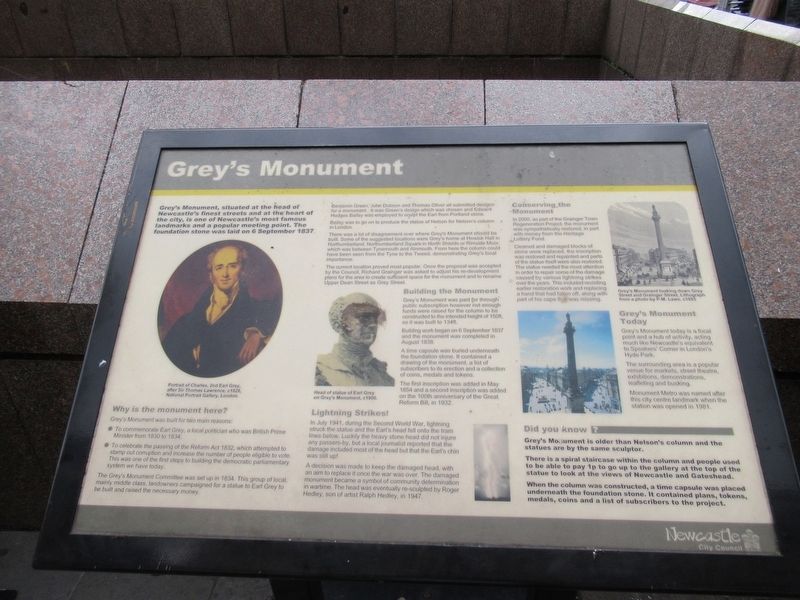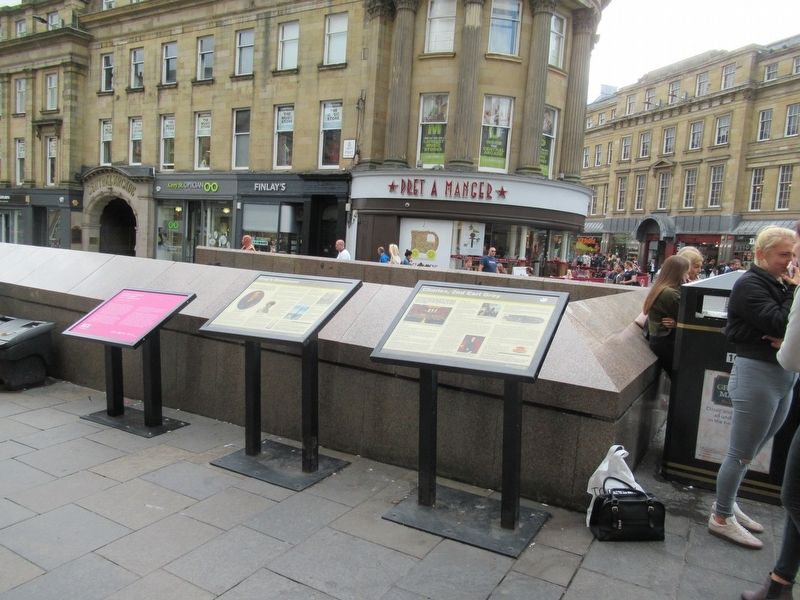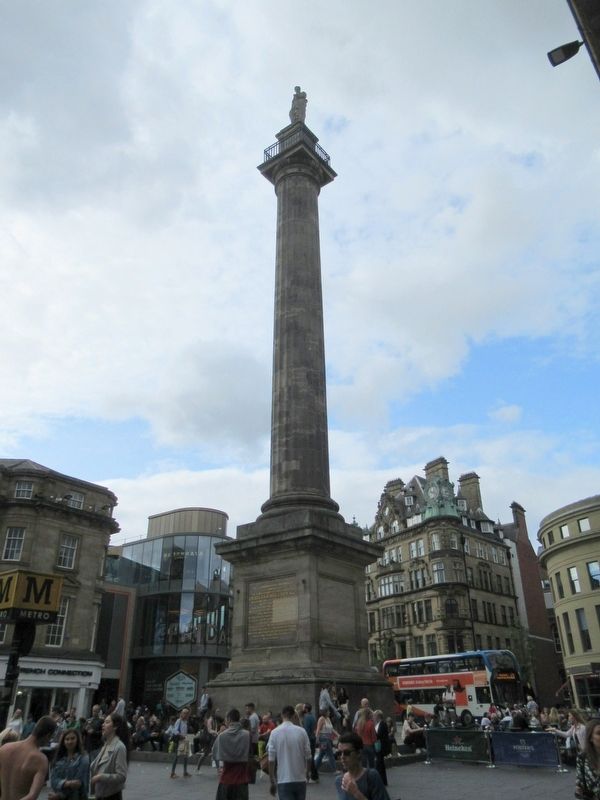Newcastle upon Tyne in Tyne and Wear, England, United Kingdom — Northwestern Europe (the British Isles)
Grey’s Monument
Grey’s Monument
Grey's Monument, situated at the head of Newcastle's finest streets and at the heart of the city, is one of Newcastle's most famous landmarks and a popular meeting point. The foundation stone was laid on 6 September 1837.
Why is the monument here?
Grey's Monument was built for two main reasons:
• To commemorate Earl Grey, a local politician who was British Prime Minister from 1830 to 1834;
• To celebrate the passing of the Reform Act 1832, which attempted to stamp out corruption and increase the number of people eligible to vote. This was one of the first steps to building the democratic parliamentary system we have today.
The Grey's Monument Committee was set up in 1834. This group of local, mainly middle class, landowners campaigned for a statue to Eari Grey to be built and raised the necessary money.
Benjamin Green, John Dobson and Thomas Oliver all submitted designs for a monument. It was Green's design which was chosen and Edward Hodges Bailey was employed to sculpt the Earl from Portland stone.
Bailey was to go on to produce the statue of Nelson for Nelson's column in London.
There was a lot of disagreement over where Grey's Monument should be built. Some of the suggested locations were Grey's home at Howick Hall in Northumberland, Northumberland Square in North Shields or Rimside Moor, which was between Tynemouth and Alnmouth. From here the column could have been seen from the Tyne to the Tweed, demonstrating Grey's local importance.
The current location proved most popular. Once the proposal was accepted by the Council, Richard Grainger was asked to adjust his re-development plans for the area to create sufficient space for the monument and to rename Upper Dean Street as Grey Street.
Building the Monument
Grey's Monument was paid for through public subscription however not enough funds were raised for the column to be constructed to the intended height of 150ft, so it was built to 134ft.
Building work began on 6 September 1837 and the monument was completed in August 1838.
A time capsule was buried underneath the foundation stone. It contained a drawing of the monument, a list of subscribers to its erection and a collection of coins, medals and tokens.
The first inscription was added in May 1854 and a second inscription was added on the 100th anniversary of the Great Reform Bill, in 1932.
Lightning Strikes!
In July 1941, during the Second World War, lightning struck the statue and the Earl's head fell onto the tram lines below. Luckily the heavy stone head did not injure any passers-by, but a local journalist reported that the damage included most of the head but that the Earl's chin was still up!
A decision was made to keep the damaged head, with an aim to replace it once the war was over. The damaged monument became a symbol of community determination in wartime. The head was eventually re-sculpted by Roger Hedley, son of artist Ralph Hedley, in 1947.
Conserving the Monument
In 2000, as part of the Grainger Town Regeneration Project, the monument was sympathetically restored, in part with money from the Heritage Lottery Fund.
Cleaned and damaged blocks of stone were replaced, the inscription was restored and repainted and parts of the statue itself were also restored. The statue needed the most attention in order to repair some of the damage caused by various lightning strikes over the years. This included revisiting earlier restoration work and replacing a hand that had fallen off, along with part of his cape that was missing.
Grey's Monument Today
Grey's Monument today is a focal point and a hub of activity, acting much like Newcastle's equivalent to Speakers' Corner in London's Hyde Park.
The surrounding area is a popular venue for markets, street theatre, exhibitions, demonstrations, leafleting and busking.
Monument Metro was named after this city centre landmark when the station was opened in 1981.
Did you know ?
Grey's Monument is older than Nelson's column and the statues are by the same sculptor.
There is a spiral staircase within the column and people used to be able to pay 1p to go up to the gallery at the top of the statue to look at the views of Newcastle and Gateshead.
When the column was constructed, a time capsule was placed underneath the foundation stone. It contained plans, tokens, medals, coins and a list of subscribers to the project.
( photo captions )
Portrait of Charles, 2nd Earl Grey, after Sir Thomas Lawrence, c1828, National Portrait Gallery, London.
Head of statue of Earl Grey on Grey’s Monument, c1900.
Grey’s Monument looking down Grey Street and Grainger Street. Lithograph from a photo by P.M. Laws. c1885
Erected by Newcastle City Council.
Topics and series. This historical marker and monument is listed in this topic list: Government & Politics. In addition, it is included in the Time Capsules series list. A significant historical month for this entry is May 1854.
Location. 54° 58.421′ N, 1° 36.773′ W. Marker is in Newcastle upon Tyne, England, in Tyne and Wear. Marker is at the intersection of Grey Street and Blackett Street, on the left when traveling north on Grey Street. Touch for map. Marker is in this post office area: Newcastle upon Tyne, England NE1 5AF, United Kingdom. Touch for directions.
Other nearby markers. At least 8 other markers are within walking distance of this marker. Charles, 2nd Earl Grey (here, next to this marker); Charles Earl Grey (a few steps from this marker); Suffragette Movement (about 150 meters away, measured in a direct line); Jose Maria de Eca de Quiros (about 180 meters away); Cathedral Church of St. Nicholas (approx. 0.4 kilometers away); Victoria R I (approx. 0.4 kilometers away); Ever Tower (approx. 0.4 kilometers away); Charles Avison (approx. 0.4 kilometers away). Touch for a list and map of all markers in Newcastle upon Tyne.
Also see . . . Charles Grey, 2nd Earl Grey on Wikipedia. (Submitted on November 22, 2018, by Michael Herrick of Southbury, Connecticut.)
Credits. This page was last revised on January 27, 2022. It was originally submitted on November 22, 2018, by Michael Herrick of Southbury, Connecticut. This page has been viewed 262 times since then and 26 times this year. Photos: 1, 2, 3. submitted on November 22, 2018, by Michael Herrick of Southbury, Connecticut.


